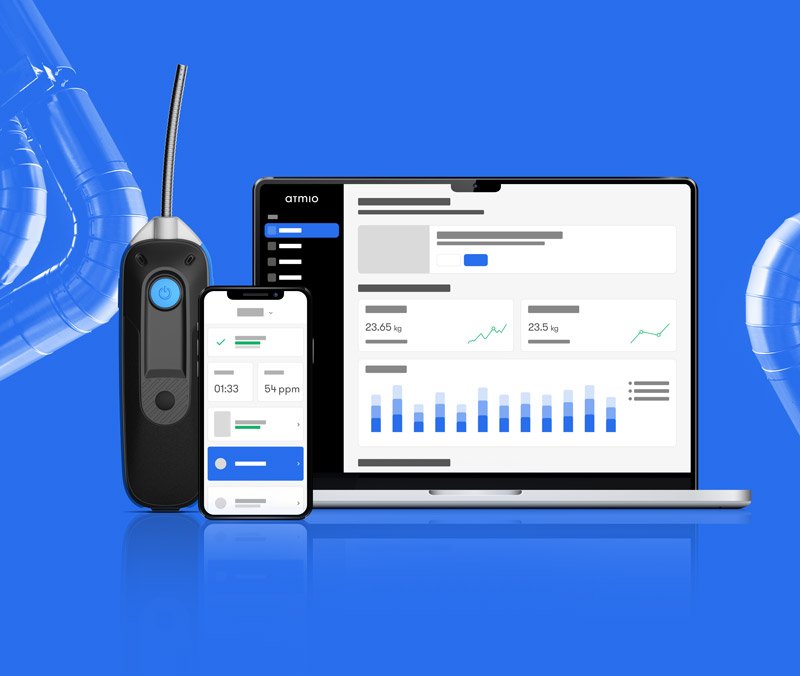Hamburg-based atmio emerges from stealth today revealing its operating system that’s taking on climate change, but not in the way you might think.
More often than not, when the topic of climate change is addressed, the meat and bones of the conversation centre around carbon dioxide. While there’s no denying the detrimental effects of the excessive amounts of CO² present in the Earth’s atmosphere, there is a far more planet-harming greenhouse gas present, one that accounts for approximately 30 per cent of global warming — methane (CH⁴).
The big deal
As defined under the Kyoto Protocol, the seven major greenhouse gases are:
- Carbon dioxide (CO²)
- Methane (CH⁴)
- Nitrous oxide (N2O²)
- Hydrofluorocarbons (HFCs)
- Perfluorocarbons (PFCs)
- Sulphur hexafluoride (SF⁶)
- Nitrogen trifluoride (NF³)
These gases are known to contribute to climate change due to their positive radiative forcing effect, a process that essentially traps heat in the Earth’s atmosphere. Due to the unique chemical structure of each gas, absorption rates vary, with methane topping the list in terms of properties conducive to the absorption of thermal radiation.
So conducive that methane is capable of absorbing approximately 120x more thermal radiation over a 10-year period, approximately 85x more over a 20-year time frame, and roughly 25x more over a century.
Silver(ish?) linings
The half-life of Methane is approximately 10 years, after which it oxidises to carbon dioxide (CO², still not great, but nowhere near as harmful as CH⁴) and water.
While methane is produced as organic matter breaks down, think landfills and wastewater treatment plants, and via the digestive process of livestock, it’s considered a trace gas, accounting for 0.00017% (1.7 parts per million by volume) of the Earth’s atmosphere.
Trapped. For now
The key word here is atmosphere, for vast quantities of methane are trapped in seafloor sediments or polar ice caps. Polar ice caps, areas of the Earth that receive less energy in the form of solar radiation resulting in lower surface temperatures.
However, if surface temperatures across the globe were to increase and these polar ice caps began (and already have) to melt … the dangers become readily apparent.
For this very reason, the UN Environmental Programme has concluded:
“Slashing emissions of methane is the single fastest way to tackle climate change.”
A warm home, a leaky faucet
A central problem in the fight to tame climate change, particularly when it comes to methane, lies in the fact that natural gas, a product used widely in industrial and residential applications, I like my home heating system too, is largely comprised of methane.
The business of delivering natural gas, i.e., methane, from source to sink is facilitated by multinational energy conglomerates that for years have factored a certain percentage of leakages into their overall deliverables.
While this process has been deemed acceptable in the past, governments are becoming increasingly aware of the dangers of methane and imposing policies to dramatically reduce the amount of methane leaking into the atmosphere, ultimately impacting suppliers.
Ground level
 Speaking to atmio co-founder and CEO Matthias Schmittmann, he explained that there are methane leakage monitoring processes already in place beginning with the macro and drilling down to the micro via satellites, drones, airplanes, stationary monitoring facilities, and handheld devices.
Speaking to atmio co-founder and CEO Matthias Schmittmann, he explained that there are methane leakage monitoring processes already in place beginning with the macro and drilling down to the micro via satellites, drones, airplanes, stationary monitoring facilities, and handheld devices.
The latter is where atmio fits into the matrix, offering a ground-level hardware and software solution to natural gas operators that seeks to replace antiquated processes and methods of leak detection and repair.
According to Schmittmann, atmio’s singular solution has the potential to find, fix, and report methane emissions 10x faster than today’s de facto methods, and is 100 per cent compliant with EU methane regulations.
One leak at a time
Schmittmann, who previously built and sold the gas detection startup bentekk to safety technology giant Dräger, and his co-founder Marius Krüger, a serial entrepreneur who also lays claim to nearly five years of experience at BP, say that atmio’s team has built a software-hardware solution in record-time that instantly helps customers:
"Within a few months, we developed the industry's operating system to find, fix and report methane emissions. Our customers already started using the solution, reducing greenhouse gas emissions one leak at a time."
atmio has raised €1.3 million to date in a pre-seed/angel investor round and is backed by HCVC, Robin Capital, and Nucleus Capital, alongside industry experts including longtime Dräger executive Bernhard Mohr. The startup is currently fundraising for its next round.
On the investment, Robin Capital's Robin Haak commented:
"Considering methane’s very high global warming potential, over 80 times more than CO2, its abatement is a low hanging fruit in tackling climate change. Yet, investments in respective solutions are surprisingly underrepresented with few companies operating in this space.
With atmio, Matthias and Marius are on track to not only becoming a market leader in its field, but a leader when it comes to stopping greenhouse gases getting into the atmosphere."
Lead image: atmio co-founder and COO Marius Krüger and co-founder and CEO Matthias Schmittmann (left to right)



Would you like to write the first comment?
Login to post comments